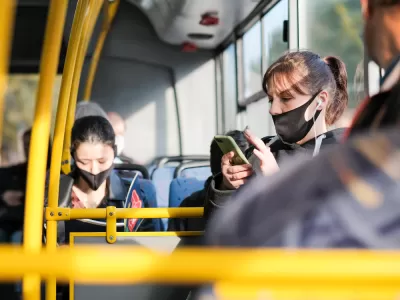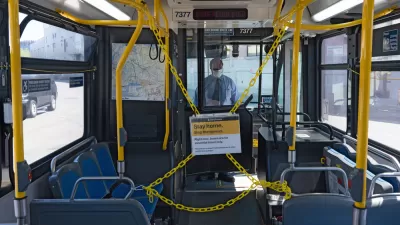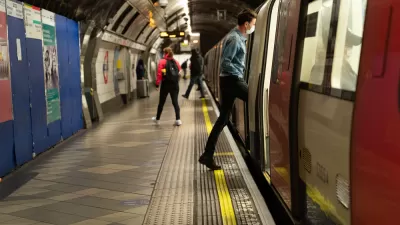Why is it hard for transit agencies to enforce pro-mask rules?

A few weeks ago, a certain relative of mine (who I shall call "R") was in a difficult situation. She got a part-time job, which required her to take a commuter train to Newark, New Jersey and a bus through the city of Newark to get to the job. She was not afraid to travel on the commuter train; it wasn’t very crowded, and people were generally wearing masks to reduce the risk of COVID-19 infection. But the bus was different; even though it was not enormously crowded, people were not always wearing masks, or were wearing them improperly, or were engaging in the sort of long cell phone conversations that are more likely to spread the virus. As a result, she quit the job.
Shortly afterwards, R asked me why the transit agency was not more aggressive about requiring riders to wear masks.* At first glance, this seems like an easy decision: if people are afraid to ride the bus because of unmasked riders, they won't. So why might a driver not enforce this rule?
First of all, agency every minute the bus driver spends arguing with riders is a minute more of delay that inconveniences people waiting for the bus. So the driver has to weigh two evils: the risk of infection from unmasked riders and the less dangerous, but more frequent, harm from sluggish buses.
Second, because talking loudly spreads the virus, arguing with riders also creates a public health risk: an argument means that a possibly-infected rider might talk even more and spread even more risk, and that a possibly-infected bus driver might talk and do the same. And since bus drivers might get closer to the rider in order to argue or to physically eject the rider, this too increases the risk of infection (because being ten feet from the rider is less risky than being two feet from the rider).
Third, if the rider is extremely unwilling to comply the driver might call the police to eject the rider—but this creates more risk in two ways. First, if the rider is infected the police might get infected as well. Second, if interactions become violent, that might cause someone to visit an emergency room, overburdening the health care system or even infecting doctors and nurses. Occasionally, violent interactions between police and citizens lead to riots, creating even more harm to a wide variety of persons.
Like many other rules, the "masks on buses" rule works only work if almost everyone is willing to comply without coercion. Once a critical mass of people decide to violate the rules, enforcement becomes extremely costly.
*One alternative might be to prominently post "how to wear a mask" notices. Although this would probably increase compliance with pro-mask rules, I suspect it would not lead to 100% compliance.

Study: Maui’s Plan to Convert Vacation Rentals to Long-Term Housing Could Cause Nearly $1 Billion Economic Loss
The plan would reduce visitor accommodation by 25,% resulting in 1,900 jobs lost.

North Texas Transit Leaders Tout Benefits of TOD for Growing Region
At a summit focused on transit-oriented development, policymakers discussed how North Texas’ expanded light rail system can serve as a tool for economic growth.

Using Old Oil and Gas Wells for Green Energy Storage
Penn State researchers have found that repurposing abandoned oil and gas wells for geothermal-assisted compressed-air energy storage can boost efficiency, reduce environmental risks, and support clean energy and job transitions.

Private Donations Propel Early Restoration of Palisades Playground
Los Angeles has secured over $1.3 million in private funding to restore the Pacific Palisades playground months ahead of schedule, creating a modern, accessible space that supports community healing after recent wildfires.

From Blight to Benefit: Early Results From California’s Equitable Cleanup Program
The Equitable Community Revitalization Grant (ECRG) program is reshaping brownfield redevelopment by prioritizing projects in low-income and environmental justice communities, emphasizing equity, transparency, and community benefits.

Planting Relief: Tackling Las Vegas Heat One Tree at a Time
Nevada Plants, a Las Vegas-based nonprofit, is combating the city’s extreme urban heat by giving away trees to residents in underserved neighborhoods, promoting shade, sustainability, and community health.
Urban Design for Planners 1: Software Tools
This six-course series explores essential urban design concepts using open source software and equips planners with the tools they need to participate fully in the urban design process.
Planning for Universal Design
Learn the tools for implementing Universal Design in planning regulations.
Ascent Environmental
Borough of Carlisle
Institute for Housing and Urban Development Studies (IHS)
City of Grandview
Harvard GSD Executive Education
Toledo-Lucas County Plan Commissions
Salt Lake City
NYU Wagner Graduate School of Public Service





























